Some of us at The Urbanist have discussed highlighting the role of education and improving Seattle public schools as a central plank of Seattle urbanism looking into the future. We aim to bring more articles on that topic. Let’s start with the low-hanging fruit of a long-delayed, much-anticipated prospect of a Downtown school. The time may finally be ripe.
Seattle Booming, Most Of All Downtown
Seattle is booming right now. In 2014, Seattle added 8,311 housing units and a similar amount in 2015. That level of development has translated into population growth in the neighborhood of 60,000 since the Seattle’s 2010 Census total of 608,660. Looking ahead, 21,600 units are in the pipeline, and even more are expected by 2020, as Mark Stiles reports: “Of the nearly 58,000 units developers hope to open between 2016 and 2020, almost 36,000 are in Seattle.”
Seattle looks like it’s on a path of robust growth. In fact, even adding upwards of ten thousand housing units per year still has not appeared to satiate demand judging by prices. Rent increases are slowing but make no mistake: Seattle rents are still climbing (recent number was 4.6% year to year) and vacancies are still low (3.5%). It would seem Seattle could support even more housing growth than it has experienced.
Growing School Age Population Too
With all that population growth, is Seattle school age population also growing? CityLab recently ran a piece suggesting we’ve reached “peak Millennial” and cities will actually shrink again. The argument goes that demography tells us the next cohorts coming of age simply aren’t as large (although the role of immigration wasn’t discussed). Moreover, the line of reasoning goes that young people will surely move to the suburbs when they start raising families in search of better schools.
While I think talk of shrinking cities is overblown (and based on bad number crunching), Seattle certainly should seek to strengthen its schools to retain and attract more residents seeking to raise families. Even as it stands, our public school enrollment is growing.
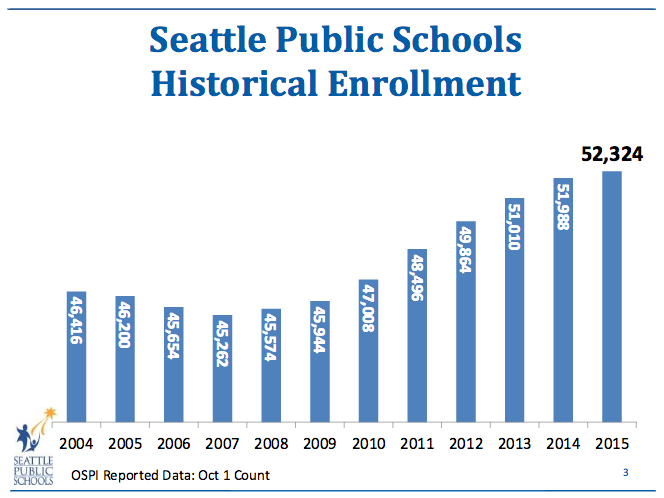
The enrollment spike doesn’t seem to be a blip in the radar, but rather a building long-term trend. For confirmation of this, look to birth statistics. Resident births have also been creeping up, even as Seattle maintains a reputation of a city that raises dogs and cats rather than humans.
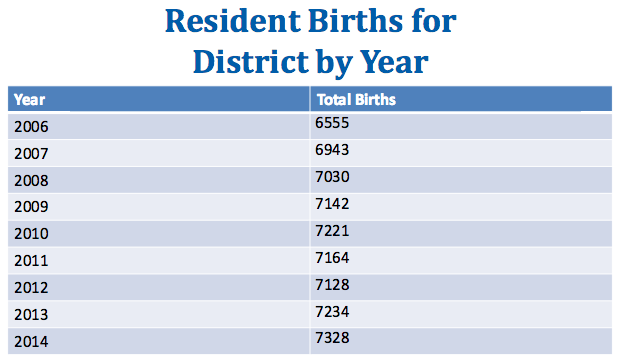
Importantly, the enrollment growth has been strongest in Downtown Seattle, making the need for infrastructure even more acute.
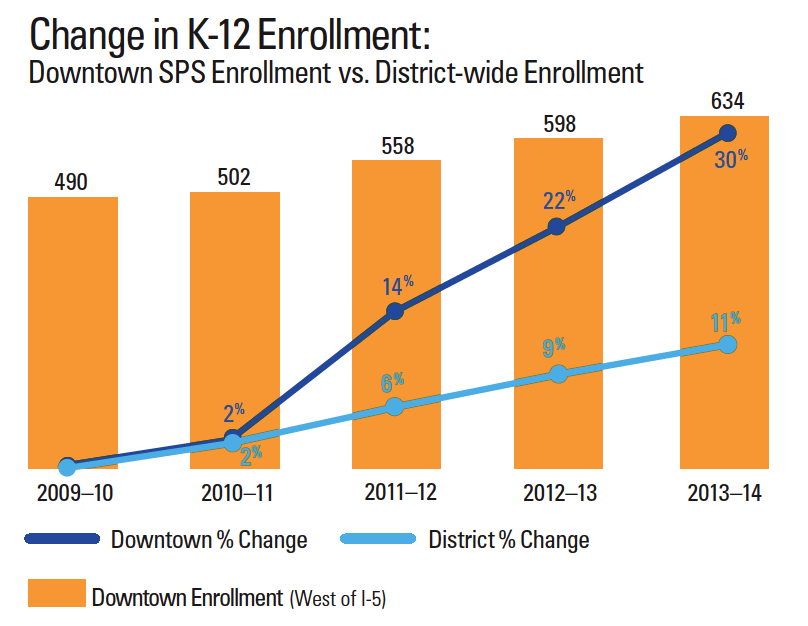
Building A School Downtown
People have been talking about building a Downtown elementary school for quite a while, and the Downtown core continues to lead Seattle in housing growth while having no school. Influential groups like the Downtown Seattle Association (DSA) have been working toward that end. It’s time to get it done.
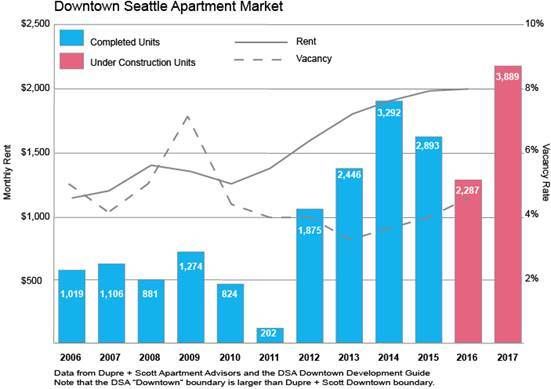
Skeptics of a Downtown school often contend Downtown residents do not want families. They are busy professionals or retirees. Or if they do have kids, they would be wealthy enough to put them in private school. The data does not support that, as Marc Stiles reported:
According to the DSA, there’s a strong need for a school downtown. The group points to demographic data that show downtown has been the city’s fastest-growing neighborhood for nearly 25 years and that the population of nearly 60,000 has the highest concentration of 25- to 34-year-olds in Seattle, a good predictor of future families.
In addition, more than 70 kindergarteners living downtown enrolled in Seattle Public Schools in 2012, up from 34 in 2007. Three years ago, 265 children were born to parents who lived downtown, compared with 110 babies born to downtown parents in 2001. Yet downtown, which the DSA said is the city’s most populous neighborhood, is one of few areas without a neighborhood school.
In January 2015, the school board competed in an auction for Seattle’s branch of the Federal Reserve Bank (the Fed moved to Renton in 2008), which seemed the perfect size for an elementary school intended to serve about 600 students. Unfortunately, the $6 million budgeted for the property wasn’t even close to the winning bid of $16 million that real estate developer Martin Selig ultimately paid. Selig now has an ambitious plan to build a 29-story glass tower on top of the six-story building. The sale indicates how expensive competing for Downtown real estate could end up being for Seattle Public Schools.
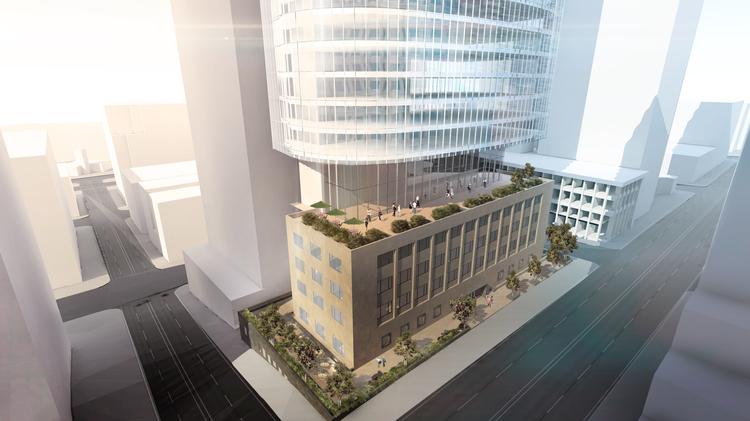
The fact that Seattle Public Schools budgeted $6 million for land shows the school district is ready to get the ball rolling. It turned out it wasn’t nearly enough money, but that amount of money should be enough to leverage some piece of property, perhaps one owned by the City or a public utility maybe.
If only the City or perhaps some benevolent private citizen would step up and offer the school district a property at a reasonable price. We think there may be opportunity for the City to build a mixed-income tower with a joint middle school and elementary school at the base. This would make best use of precious Downtown core land owned by the public. It would lessen the school’s cost to the school district while also meeting the need for more affordable and workforce housing in the city.
Imagine it: a Downtown school and a Downtown apartment where a person living on a teacher’s salary could live in. It’s possible.

Whatever the solution, the City will have to get creative because it is unlikely Seattle Public Schools could easily afford prime Downtown real estate if the going rate is around $16 million just for land. Building a Downtown elementary and middle school is important to Seattle’s development, especially if current trends of housing growth in the core continue. Cutting down the distance Downtown residents have to commute to school fits with Seattle’s goal of creating safe routes to school for all kids. And a Downtown school might finally light a fire under the City’s bureaucratic behind to stop delaying and create a safe bike network Downtown.
Doug Trumm is publisher of The Urbanist. An Urbanist writer since 2015, he dreams of pedestrian streets, bus lanes, and a mass-timber building spree to end our housing crisis. He graduated from the Evans School of Public Policy and Governance at the University of Washington in 2019. He lives in Seattle's Fremont neighborhood and loves to explore the city by foot and by bike.


